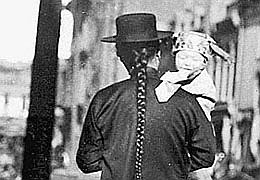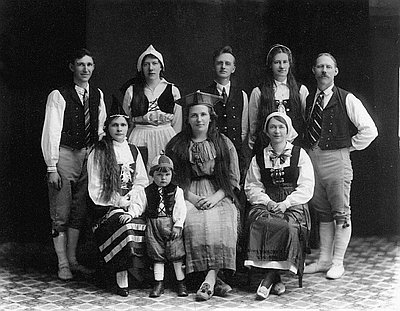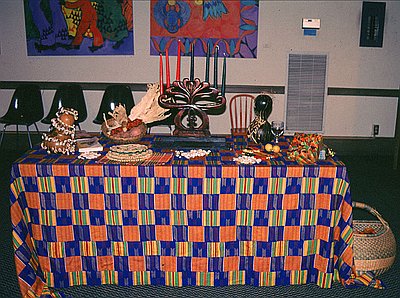Folklife Bibliography
Aarne, Anti, and Stith Thompson. The Types of the Folktale: A Classification and Bibliography. Folklore Fellows Communication No. 180. Helsinki, Finland: Academic Scientarum Fennica, 1960.
Azuma, Eichiro. “A History of Oregon’s Issei, 1880–1952.” Oregon Historical Quarterly 94 (1993-94): 315–67.
Barber, Katrine. “Stories Worth Recording: Martha McKeown and the Documentation of Pacific Northwest Life.” Oregon Historical Quarterly 110:4 (Winter 2009): 546-569.
Beck, David R.M. “’Standing out Here in the Surf’: The Termination and Restoration of the Coos, Lower Umpqua and Siuslaw Indians of Western Oregon in Historical Perspective.” Oregon Historical Quarterly 110:1 (Spring 2009): 6-37.
Beckham, Steven Dow. Tall Tales from Rogue River: The Yarns of Hathaway Jones. Bloomington: Indiana University Press, 1974. Reprint, Oregon State University Press, 1991.
_____. The Indians of Western Oregon: This Land Was Theirs. Coos Bay, OR: Arago Books, 1977.
Benjamin, Walter. “The Task of the Translator.” In Illuminations. Trans. Harry Zohn. New York: Schocken Books, 1969.
Berg, Laura, ed. The First Oregonians. Portland: Oregon Council for the Humanities, 2007.
Browner, Tara. Heartbeat of the People: Music and Dance of the Northern Pow-Wow. Urbana: University of Illinois Press, 2002.
Brunvand, Jan Harold. The Vanishing Hitchhiker: Urban Legends and Their Meanings. New York: W.W. Norton, 1981.
Buan, Carolyn M., and Richard Lewis. The First Oregonians: An Illustrated Collection of Essays on Traditional Lifeways, Federal-Indian Relations, and the State’s Native People Today. Portland: Oregon Council for the Humanities, 1991.
Cannon, Hal, ed. New Cowboy Poetry: A Contemporary Gathering. Layton, UT: Peregrine Smith Books, 1990.
Childs, Leila. Chinese Traditions of Oregon. Oregon Folklife Series. Portland: Oregon Historical Society, 1998.
_____. Lao Traditions of Oregon. Oregon Folklife Series. Portland: Oregon Historical Society, 1998.
Clifford, James. The Predicament of Culture: Twentieth-Century Ethnography, Literature, and Art. Cambridge, Mass.: Harvard University Press, 1988.
Crystal, Eric. “Language and Culture: A Mien Refugee Perspective.” In American Folklife Festival Catalogue. Washington, D.C.: Smithsonian Institution Press, 1987.
Dobkins, Rebecca J. “Exhibit Essay: Life Stories for New Generations: The Living Art of Oregon Tribal Regalia.” Oregon Historical Quarterly 110:3 (Fall 2009): 420-439.
Dorson, Richard M. “Material Component in Celebration.” In Celebration: Studies in Festivity and Ritual, ed. Victor Turner. Washington, D.C.: Smithsonian Institution Press, 1982.
Falassi, Alessandro. Time Out of Time: Essays on the Festival. Albuquerque: University of New Mexico Press, 1986.
Fiset, Louis and Gail M. Nomura. Nikkei in the Pacific Northwest: Japanese Americans and Japanese Canadians in the Twentieth Century. Seattle: University of Washington Press, 2005.
Fisher, Andrew H. Shadow Tribe: The Making of Columbia River Indian Identity. Seattle: University of Washington Press, 2010.
Fixico, Donald L. Indian Resilience and Rebuilding: Indigenous Nations in the Modern American West. Tucson: University of Arizona Press, 2013.
Gamboa, Erasmo. Mexican Labor and World War II: Braceros in the Pacific Northwest, 1942-1947. Austin: University of Texas Press, 1990.
_____ and Carolyn M. Buan, eds. Nosotros: The Hispanic People of Oregon. Portland: Oregon Council for the Humanities, 1995.
Gilmore, Janet. The World of the Oregon Fishboat: A Study in Maritime Folklife. Pullman: Washington State University Press, 1999.
Gonzales-Berry, Erlinda, and Marcela Mendoza. Mexicanos in Oregon: Their Stories, Their Lives. Corvallis: Oregon State University, 2010.
Hussa, Lind, and Madelein Graham Blake. The Family Ranch: Land, Children, and Tradition in the American West. Reno: University of Nevada Press, 2010.
Hymes, Dell. “Folklore’s Nature and the Sun’s Myth.” Journal of American Folklore 88 (1975): 345–69.
_____. “In Vain I Tried to Tell You”: Essays in Native American Ethnopoetics. Philadelphia: University of Pennsylvania Press, 1981.
Hufford, Mary, ed. Conserving Culture: A New Discourse on Heritage. Urbana: University of Illinois Press, 1994.
Jacobs, Elizabeth Derr, and William R. Seaburg. The Nehalem Tillamook: An Ethnography. Corvallis: Oregon State University, 2003.
Jones, Paula. “There was a Woman: La Llarona in Oregon.” Western Folklore 47 (1988): 195–211.
Jones, Suzi, ed. Webfoots and Bunchgrassers: Folk Art of the Oregon Country. Salem: Oregon Arts Commission, 1980.
Jones, Suzi, and Jarold Ramsey, eds. The Stories We Tell: An Anthology of Oregon Folk Literature. Corvallis: Oregon State University Press, 1994.
Kapchan, Deborah A., and Pauline Turner Strong, eds. Journal of American Folklore: Special Issue on Theorizing the Hybrid 112 (1999).
Karson, Jennifered.. Wiyaxayxt / Wiyaakaa'awn / As Days Go By: Our History, Our Land, Our People: The Cayuse, Umatilla, and Walla Walla. Pendleton and Portland: Tamatslikt Cultural Institute and Oregon Historical Society Press, 2006.
Kessler, Lauren. “Spacious Dreams: A Japanese Family Comes to the Pacific Northwest.” Oregon Historical Quarterly 94 (1993): 141–66.
Kirshenblatt-Gimblett, Barbara. “Mistaken Dichotomies,” Journal of American Folklore 101 (1988): 140–55.
Lowenstein, Steven. The Jews of Oregon, 1850–1950. Portland, OR: Jewish Historical Society, 1987.
MacDonald, Jeffery L. Transnational Aspects of Iu-Mien Refugee Identity. New York: Garland Publications, 1997.
Marcus, Laura. Traditional Arts of the Oregon Country. Oregon Folklife Series. Portland: Oregon Historical Society, 2002.
_____. “Oregon Folklore: Following Commitments Homeward.” Oregon Humanities (Spring 2000): 53–57.
_____. In My Country: A Gathering of Refugee and Immigrant Fiber Traditions. Portland, OR: Immigrant Refugee Community Organization, 2003.
McCowan, Karen. “Tribal Elder Keeps Salmon Ceremony Going Strong,” (Eugene) Register-Guard, June 20, 2004.
Mendoza, Marcela. “Latinas and Citizenship in Oregon.” Oregon Historical Quarterly 113:3 (Fall 2012): 444-51.
Monroe, Sarah Baker. “Basque Folklore in Southeastern Oregon.” Oregon Historical Quarterly 76 (1975): 153–74.
Mulcahy, Joanne B. “Oregon Voices: ‘Know Who You Are’: Regional Identity in the Teachings of Eva Castellanoz.” Oregon Historical Society 108:3 (Fall 2007): 444-457.
_____. Remedios: The Healing Life of Eva Castellanoz. San Antonio: Trinity University Press, 2010.
Nagae, Peggy. “Asian Women: Immigration and Citizenship in Oregon.” Oregon Historical Quarterly 113:3 (Fall 2012): 334-59.
Nash, Tom, and Twilo Scofield. The Well-Traveled Casket: A Collection of Oregon Folklife. Salt Lake City: University of Utah Press, 1992.
Nusz, Nancy, and Gabriella Ricciardi. “Oregon Voices: Our Ways: History and Culture of Mexicans in Oregon.” Oregon Historical Society 104:1 (Spring 2003): 110-23.
O’Donnell, Terence. That Balance So Rare: The Story of Oregon. Portland: Oregon Historical Society Press, 1988.
Oring, Elliott. Jokes and their Relations. Lexington: University Press of Kentucky, 1992.
Pratt, Mary Louise. “Arts of the Contact Zone.” In Ways of Reading, ed. David Bartholomae and Anthony Petroksky. 5th ed. New York: Bedford/St. Martin’s, 1999.
Ramsey, Jarold. New Era: Reflections on the Human and Natural History of Central Oregon. Corvallis: Oregon State University Press, 2003.
_____, ed. Coyote Was Going There: Indian Literature of the Oregon Country. Seattle: University of Washington Press, 1977.
Redfield, Robert. The Little Community and Peasant Society and Culture. Chicago: University of Chicago Press, 1960.
Reid, Kay. “Multilayered Loyalties: Oregon Indian Women as Citizens of the Land, Their Tribal Nations, and the United States.” Oregon Historical Society 113:3 (Fall 2012): 392-407.
Robbins, William G. “‘the kind of person who makes this America strong’: Monroe Sweetland and Japanese Americans.” Oregon Historical Society 113:2 (Summer 2012): 198-229.
Robe, Stanley. “Basque Tales from Eastern Oregon.” Western Folklore 12 (1953): 153–57.
Rodriguez, Jeanette. Our Lady of Guadalupe: Faith and Empowerment among Mexican-American Women. Austin: University of Texas Press, 1994.
Santino, Jack. All Around the Year: Holidays and Celebrations in American Life. Urbana: University of Illinois Press, 1995.
Simpson, Peter K. The Community of Cattlemen: A Social History of the Cattle Industry in Southeastern Oregon, 1869–1912. Moscow: University of Idaho Press, 1987.
Schoemaker, George H., ed. The Emergence of Folklore in Everyday Life: A Fieldguide and Sourcebook. Bloomington, IN: Trickster Press, 1990.
Tamura, Linda. The Hood River Issei: An Oral History of Japanese Settlers in Oregon’s Hood River Valley. Urbana: University of Illinois Press, 1993.
Toelken, Barre. The Dynamics of Folklore. Boston, MA: Houghton Mifflin, 1979.
Turner, Kay. Beautiful Necessity: The Art and Meaning of Women’s Altars. New York: Thames and Hudson, 1999.
Turner, Rory, and Phillip H. McArthur. “Cultural Performance: Public Display Events and Festival.” In The Emergence of Folklore in Everyday Life: A Fieldguide and Sourcebook, ed. George H. Schoemaker. Bloomington, IN: Trickster Press, 1990.
Uecker, Jeffry. “Portland’s Gettysburg Cyclorama: A Story of Art, Entertainment, and Memory.” Oregon Historical Quarterly 113:1 (Spring 2012): 36-61.
Ulrich, Roberta. American Indian Nations from Termination to Restoration, 1953-2006. Lincoln: University of Nebraska Press, 2010.
Whaley, Gray. Oregon and the Collapse of Illahee: U.S. Empire and the Transformation of an Indigenous World. Chapel Hill: University of North Carolina Press, 2010.
Whisnant, David. All That Is Native and Fine: The Politics of Culture in an American Region. Chapel Hill: University of North Carolina Press, 1983.
Jun Xing, Erlinda Gonzales-Berry, Patti Sakurai, Robert D. Thompson Jr., and Kurt Peters, eds. Seeing Color: Indigenous Peoples and Racialized Ethnic Minorities in Oregon. Lanham, MD: University Press of America, 2007.
Zeitlin, Steve, Amy Kotkin, and Holly Cutting Baker. A Celebration of American Family Folklore. New York: Pantheon, 1982.
Zenk, Henry. “Notes on Native American Place-Names of the Willamette Valley Region.” Oregon Historical Quarterly 109:1 (Spring 2008): 6-33.
© Joanne B. Mulcahy, 2005. Updated and revised by OHP staff, 2014.


